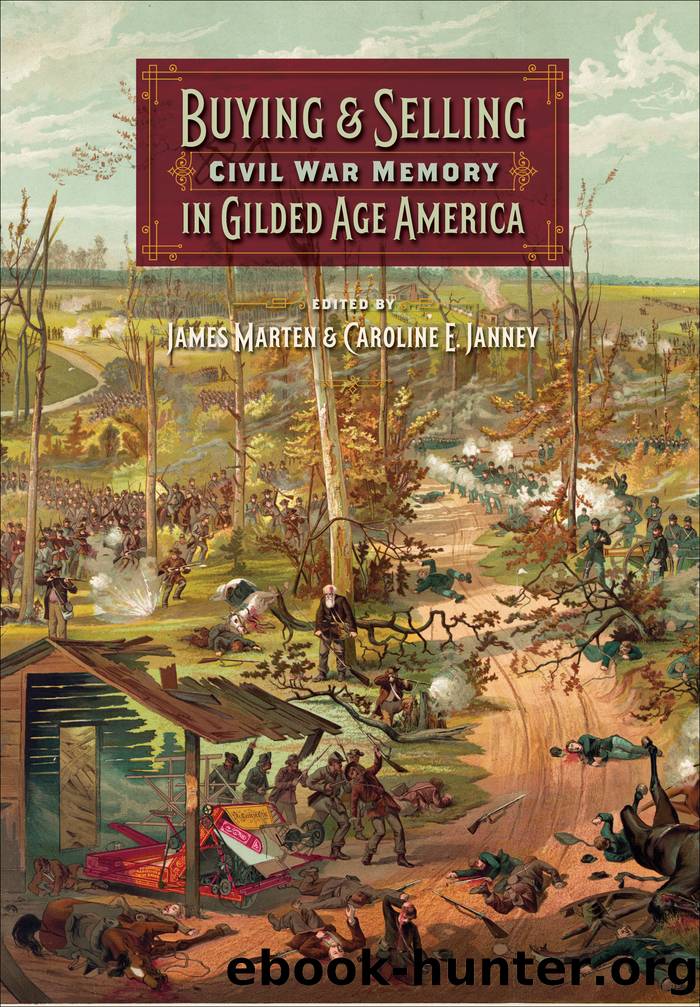Buying and Selling Civil War Memory in Gilded Age America by James Marten;Caroline E. Janney;

Author:James Marten;Caroline E. Janney;
Language: eng
Format: epub
Publisher: Lightning Source Inc. (Tier 3)
Published: 2021-01-15T00:00:00+00:00
NOTES
1. Ulysses S. Grant, âInaugural Address,â March 4, 1869, American Presidency Project, https://www.presidency.ucsb.edu/node/203651, accessed July 31, 2020.
2. The advertisements studied in this chapter are housed in archival collections at Yale University, Duke University, and the American Antiquarian Society. For studies of advertisements and Civil War memory, see Kenneth Goings, Mammy and Uncle Mose: Black Collectibles and American Stereotyping (Bloomington: Indiana University Press, 1994); Karen Cox, Dreaming of Dixie: How the South was Created in American Popular Culture (Chapel Hill: University of North Carolina Press, 2011); Robert J. Cook, Troubled Commemoration: The American Civil War Centennial, 1961â1965 (Baton Rouge: Louisiana State University Press, 2007); and Amanda Bellows, American Slavery and Russian Serfdom in the Post-Emancipation Imagination (Chapel Hill: University of North Carolina Press, 2020). In Remembering the Civil War: Reunion and the Limits of Reconciliation (Chapel Hill: University of North Carolina Press, 2013), Caroline E. Janney argues that race played a role in reconciliation, but was not the driving force of the phenomenon (199â200). By contrast, David Blight posits in Race and Reunion: The Civil War in American Memory (Cambridge, Mass.: Belknap Press of Harvard University, 2001) that reunion was made possible through racial oppression (139).
3. Juliann Sivulka, Soap, Sex, and Cigarettes: A Cultural History of American Advertising (Boston: Cengage Learning, 2011), 46.
4. Blue Book on Advertising (New York: J. Walter Thompson Company, 1901), 11, box DG4 C. 1, J. Walter Thompson Company, Domestic Advertisements Collection and Publications Collection, David M. Rubenstein Rare Book and Manuscript Library, Duke University.
5. Kristin Hoganson, Consumersâ Imperium: The Global Production of American Domesticity, 1865â1920 (Chapel Hill: University of North Carolina Press, 2007), 15; and âCigarettes: Men,â Coffin Nails: The Tobacco Controversy of the Nineteenth Century, published by Harp Week, https://tobacco.harpweek.com/hubpages/CommentaryPage.asp?Commentary=Men, accessed June 12, 2019.
6. Davidâs Prize Soap Company, âDavidâs Prize Soap,â late nineteenth century, Ephemera Collection box 17, American Antiquarian Society; Jennifer M. Black, âCorporate Calling Cards: Advertising Trade Cards and Logos in the United States, 1876â1890,â Journal of American Culture 32, no. 4 (2009): 291â306.
7. Black, âCorporate Calling Cards,â 292; Margaret Hale, âThe Nineteenth-Century American Trade Card,â Business History Review 74, no. 4 (2000): 683â88; Margaret Hale, âA New and Wonderful Invention: The Nineteenth-Century American Trade Card,â September 5, 2000, Harvard Business School, https://hbswk.hbs.edu/archive/a-new-and-wonderful-invention-the-nineteenth-century-american-trade-card, accessed June 19, 2018; and T. J. Jackson Lears, Fables of Abundance: A Cultural History of Advertising In America (New York: Basic Books, 1995), 55.
8. âAmerican IndustriesâNo. 68, Proprietary Specialties,â Scientific American 44, no. 13 (March 26, 1881): 194â95, quote on 194.
9. John Neff, Honoring the Civil War Dead: Commemoration and the Problem of Reconciliation (Lawrence: University of Kansas Press, 2005), 5.
10. Joanna Cohen, ââYou Have No Flag Out Yet?â: Commercial Connections and Patriotic Emotion in the Civil War North,â Journal of the Civil War Era 9 (Sept. 2019): 378â409, quote on 378.
11. âThe Centennial,â Scribnerâs Monthly 11, no. 3 (1876): 433.
12. Black, âCorporate Calling Cards,â 291â92.
13. The American colonists lost the Battle of Bunker Hill to the British in 1775, but they inflicted significant casualties on the British troops. The construction of the monument began fifty years later.
Download
This site does not store any files on its server. We only index and link to content provided by other sites. Please contact the content providers to delete copyright contents if any and email us, we'll remove relevant links or contents immediately.
In Cold Blood by Truman Capote(3127)
Steve Jobs by Walter Isaacson(2744)
The Innovators: How a Group of Hackers, Geniuses, and Geeks Created the Digital Revolution by Walter Isaacson(2404)
All the President's Men by Carl Bernstein & Bob Woodward(2248)
Lonely Planet New York City by Lonely Planet(2090)
The Room Where It Happened by John Bolton;(2022)
And the Band Played On by Randy Shilts(2001)
The Murder of Marilyn Monroe by Jay Margolis(1967)
The Poisoner's Handbook by Deborah Blum(1960)
The Innovators by Walter Isaacson(1959)
Lincoln by David Herbert Donald(1856)
A Colony in a Nation by Chris Hayes(1789)
Under the Banner of Heaven: A Story of Violent Faith by Jon Krakauer(1670)
Amelia Earhart by Doris L. Rich(1575)
The Unsettlers by Mark Sundeen(1573)
Birdmen by Lawrence Goldstone(1526)
Zeitoun by Dave Eggers(1507)
Dirt by Bill Buford(1506)
Decision Points by George W. Bush(1454)
